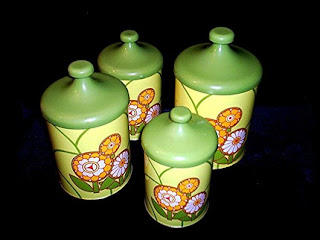One of the great changes to the traditional family home in the late seventies, was the kitchen being incorporated into the main living area. Previously, kitchens had been entirely self-contained rooms in which to prepare and eat food. Perhaps we can thank the growth of the Womens Movement for this revolution in home life. Until then, women Knew Their Place, which was often the confines of the kitchen: preparing meals, cooking, or washing dishes; certainly not distracted by *gasp* the high-mindedness of male conversation.
 |
| Would you believe these 'used' 60s ramekins are currently listed on ebay for $50? Quick, raid Mum's cupboard! |
Formal dining rooms (and not everybody had them) were used only with guests. All other meals were eaten at a table in the kitchen. Add to that the typical (nuclear) family structure of the time, rules about ‘table manners’ and you realise how very different life is today. When was the last time you heard a child being told to keep their elbows off the table?
If the aspirational kitchen of the 60s was a shiny laminated ‘mod’ experience, the 70s kitchen was quite the opposite. The “farmhouse” look was much favoured, rich in yellowed pine. A beaten copper rangehood was often the focal point. Pans dangling from ceiling hooks supposedly added to the ‘country’ feel, as did decorative cake-tins hung in random formation on the walls
As the decade wore on, cupboards in walnut stain also became popular. People with faux-Tudor leanings preferred mahogany. A timber benchtop, though desirable, was a luxury for most and somewhat impractical, so laminates still had their place. Favoured shades were lime green and egg-yolk yellow. Formica did some more upmarket heavily textured laminates, the most popular by far being a dark brown flecked with red and orange, that looked like a volcano had spewed on the benchtop.
At odds with the ‘au naturel’ vibe was the way women loved to display all their kitchen gadgets, especially electric frypans, electric can-openers, vertical grills (“what are they?” I hear the under 30s ask) and most of all, the beloved Kenwood Chef. Sets of saucepans enamelled in red, burnt orange or olive green completed the ‘look.’
Earthenware dinner sets became groovy (attractive but could get very “hot!hot!hot!”) and a set of chocolate brown coffee cups or ramekins was de rigueur.
Thank goodness wallpaper was falling out of vogue (in Australia at least. Europeans and Americans stayed with it several decades more). One of the more popular patterns here in the early 70s was a brick or lattice wall with ivy growing over it. Into the 1980s, large block-mount photos of baskets of gourds became curiously popular.
Window dressings? Where I grew up, a single style raged through every kitchen in Adelaide - cafe curtains: a frill along the top, matching half-curtain below. But the best part of the 70s house belonged to those kitchens that were still separate from the main living area but adjacent to a designated ‘meals’ area, for the two would usually be divided by a set of half-sized swinging saloon doors. Most children (and probably quite a few dads) got in touch with their inner Clint Eastwood on a daily basis.
Now if you'll excuse me, I need to go check on the Apricot Chicken Casserole.
Now if you'll excuse me, I need to go check on the Apricot Chicken Casserole.

